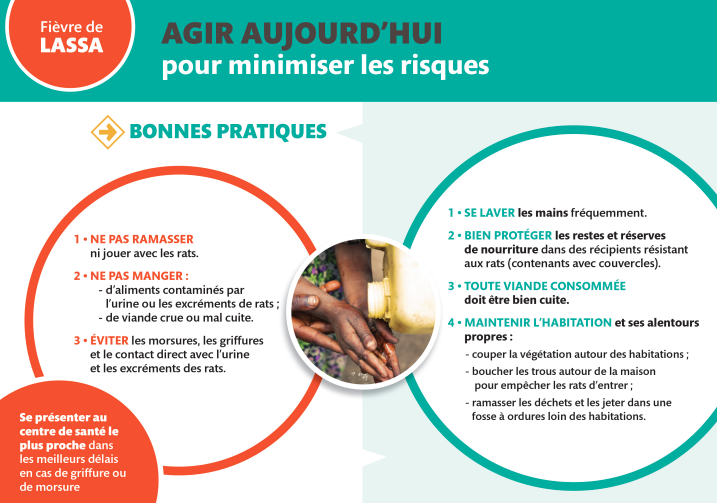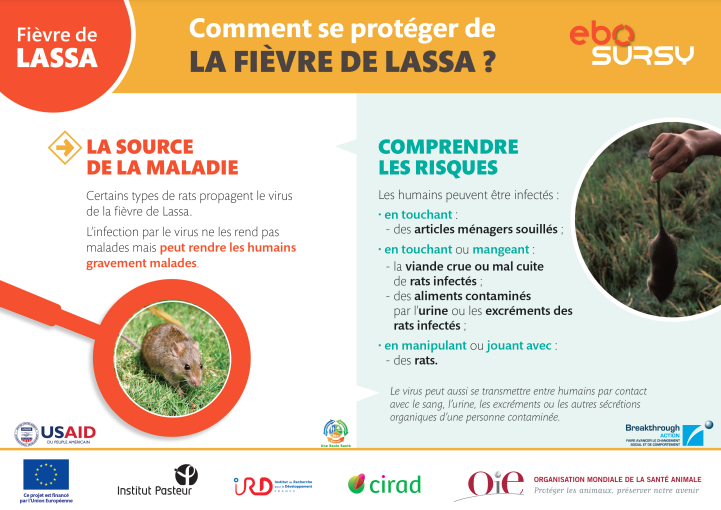Guinea: Country Profile
Guinea, with capital Conakry, is a coastal country in West Africa with a population of 13.49 million inhabitants in 2022. In Guinea, agriculture accounts for 19.7% of the total gross domestic product and employs 84% of the economically active population. There is no estimate of Guinea’s livestock population, but it is safe to assume that a significant portion of the economically active population is involved in animal husbandry, potentially affecting zoonotic diseases transmission. The West African Ebola Virus Disease (EVD) outbreak that began in Guinea in 2013 resulted in 3,814 cases and 2,544 deaths and spread to other countries in West Africa between 2014 and 2016.
The Global Health Security Agenda (GHSA) is a global cooperative working to improve preparedness and response to infectious diseases including zoonoses. As part of the GHSA work in Guinea, government stakeholders and non-governmental organization (NGO) partners identified a set of priority zoonotic diseases/disease groups (PZDs) for the country: anthrax, avian influenza, brucellosis, bovine tuberculosis, dengue, rabies, and other viral hemorrhagic fevers, such as EVD, Marburg, Rift Valley fever (RVF), and Lassa fever. A multisectoral approach – One Health – is critical for preventing and addressing zoonotic diseases in Guinea. The One Health approach recognizes the interconnectedness between human health, animal health, and the environment.

Guinea Map
Priority Zoonotic Diseases
Human anthrax is a bacterial infection that typically affects animals and can pass from animals and animal products to humans, with limited human-to-human transmission. In endemic settings, anthrax affects primarily cattle and sheep, and the spores can remain in soil for years. It can spread to humans through open wounds on the skin, ingestion, or inhaling the spores. The 2014 epidemic of anthrax disease in the Koubia prefecture was marked by a high incidence and lethality (fatality rate around 28%). As far as exposure, a retrospective study found that 35% had ingested contaminated meat and 17.95% were in direct contact with a sick animal.
Avian influenza is an infection by an influenza virus that can affect almost all species of birds, wild or domestic. It can be highly contagious, especially in chickens and turkeys, and can lead to extremely high mortality, especially in factory farms. Bird flu viruses do not normally infect humans. However, sporadic human infections with bird flu viruses have occurred. Guinea reported several outbreaks of highly pathogenic H5N1 avian influenza on farms in the western part of the country in 2022, near to the capital city, Conakry. Cases were detected between April 18 and May 10, according to a notification to the World Organisation for Animal Health. The outbreaks were the first ones reported in Guinea and were mostly found at laying hen farms according to Guinean health authorities. A total of 120,478 poultry died or were killed.
Brucellosis is a bacterial infection with a global incidence of about 500,000 cases per year worldwide and a prevalence of more than 10 cases per 100,000 population in some countries. Humans become infected through contact with sick animals, ingestion of fresh unpasteurized or unboiled/raw milk, or fresh cheese. Brucellosis has a significant impact on the health and productivity of livestock, thus greatly reducing their economic value and work performance.
Bovine tuberculosis is caused by the bacterial species Mycobacterium bovis and causes bovine tuberculosis in farm animals (and tuberculosis in other wild animals). In 2016, according to WHO estimates, 147,000 new cases of zoonotic TB were reported in humans, including 12,500 deaths.
Dengue: Dengue is a viral disease transmitted by mosquitoes. It has spread rapidly in recent years. The main predisposing factors for the occurrence of outbreaks are the high density of mosquito breeding sites, the rainy season, and the poor knowledge of communities about how mosquitoes breed and bite.
Rabies remains a widespread disease worldwide, responsible for tens of thousands of deaths each year. It is most often transmitted by dogs. In Guinea, stray dogs are present in large numbers in public places and around landfills. From 2002 to 2012, 7 994 people were concerned by domestic animal bites. Males were the most affected with 60.4% of all cases. Most injuries were to the lower limbs (54.4%). From 7 994 victims of domestic animal bites, 2 634 received post-exposure prophylaxis and the dropout rate was 51%. Rabies is a real risk in Conakry. According to the latest report from the Agence Nationale de Sécurité Sanitaire (ANSS), a case of human rabies has been detected in Senko in the Beyla prefecture. A ten-year-old girl was bitten by a dog and died. It should be noted that the epidemiological reports of the ANSS for the last three months show several dog bites in Conakry, N’Zérékoré, Faranah and Dinguiraye.
Lassa fever is an acute viral hemorrhagic disease caused by the Lassa virus. It is primarily transmitted to humans either through direct contact with infected Mastomys rodents, or through food or household items contaminated with the urine or faeces of infected rodents. About 100,000 to 300,000 infections of Lassa fever occur annually, with about 5,000 deaths worldwide. Surveillance for Lassa fever varies between locations, so these estimates are crude. It is endemic in parts of West Africa including Guinea. In Guinea, Lassa fever was first diagnosed in October 2011. Since then, outbreaks and sporadic cases have been reported in the country. In 2021, with 8 cases and 7 deaths (88% CFR) were reported in the prefectures of N’Zérékoré, Beyla, Guéckédou and Yomou. The last reported outbreak of Lassa fever in Guinea was on 22 April 2022 when the Ministry of Health and Public Hygiene of Guinea declared a Lassa fever outbreak following the laboratory confirmation of two cases from the Guéckédou prefecture in the southeast of Guinea.
Ebola and Marburg: EVD is an infection caused by a virus of the filovirus family to which the Marburg virus also belongs. Humans are infected either by direct contact with infected bats (a rare event), or by handling infected animals found dead or sick in forests (a more frequent event). Human-to-human transmission is also possible and occurs through direct contact with the blood, secretions, organs or biological fluids of infected individuals. Guinea has learned many lessons from the 2014-2016 West African EVD epidemic that it has applied to its response in 2021 during the most recent EVD epidemic.
Rift Valley fever (RVF) is an acute viral hemorrhagic fever that is most seen in domesticated animals (such as cattle, buffalo, sheep, goats, and camels) and can also cause illness in people. The disease is caused by RVF virus (RVFV). Most human infections result from direct or indirect contact with the blood or organs of infected animals. Mild symptoms include fever, muscle pains, and headaches which often last for up to a week. Severe symptoms include loss of sight beginning three weeks after the infection, infections of the brain causing severe headaches and confusion, and bleeding together with liver problems which may occur within the first few days. Those who have bleeding have a chance of death as high as 50%. In Guinea, a study found mean seroprevalence of RVF was 16.4% (76 in 463) in cattle, 1.0% (4 in 408) in goats and 1.0% (5 in 486) in sheep.
One Health Landscape
There are 47 key organizations involved in the fight against diseases with epidemic potential in Guinea at both the national and regional levels under five main categories: public (21), community (6), technical and financial partners (16), non-governmental organizations (3), private (1).
View the landscaping presentation.
Summary of existing Breakthrough ACTION research
In 2019 the Breakthrough ACTION team conducted a literature review on behavioral research conducted in West Africa and in Guinea particularly, related to zoonotic diseases. The review aimed to explore known behavioral determinants and socio-cultural norms that influence specific zoonotic diseases. Although epidemiological data on several of these diseases are available, little research exists on perceptions, attitudes, and practices related to risk and prevention behaviors for the PZDs. Most articles focus on the epidemiological or biomedical characteristics of the diseases, and less on the individual or cultural factors that influence how Guinean individuals perceive their risk of zoonotic diseases or what actions they take to reduce their risk. Due to the very limited literature on priority zoonotic diseases in Guinea, sufficient behavioral research was only available for two of the diseases: anthrax and Lassa fever. Short briefs were created for these two priority diseases.
Read the brief on anthrax and the brief on Lassa fever.
In light of this research gap, Breakthrough ACTION implemented formative, qualitative research to explore behaviors and behavioral determinants that intersect with Guinea’s PZDs. The team conducted focus group discussions, in-depth interviews, and direct observations in 3 sites in Guinea. The study included adult men and women, professional animal handlers such as farmers or butchers, veterinary staff, health workers, media professionals, and local community leaders. Focus groups explored self-efficacy and response efficacy with respect to 15 priority behaviors that create risk or help prevent zoonotic events or disease transmission. The study collected data from a total of 244 individuals (FGDs=205; IDIs=24; Observations=15). The study results produced seven cross-cutting themes which can be found in the full research report.
Read the full report summarizing findings from the formative, qualitative research in English or French.
Case study on SBC response
The research above informed several SBCC campaigns and activities based on report to foster and reinforce an effective system for the circulation of information on zoonoses, combat beliefs and practices that are unfavorable to the prevention of zoonotic diseases, enhance the use of veterinarians as major actors, and other recommendations.
The Breakthrough ACTION team and partners have conducted campaigns to address multiple behavioral determinants related to PZDs. Breakthrough ACTION has contributed to raising awareness, increasing perception of disease severity, and confidence and skills building for prevention and treatment across multiple disease areas such as Marburg, Lassa Fever, Ebola, Rabies, Avian Flu and more. Examples of campaign materials include radio spots highlighting the risk of Marburg, posters and social media posts to raise awareness about anthrax, Lassa fever, and rabies, and interactive radio shows to engage the public in discussion to improve self-efficacy with care-seeking and safe animal encounters.



